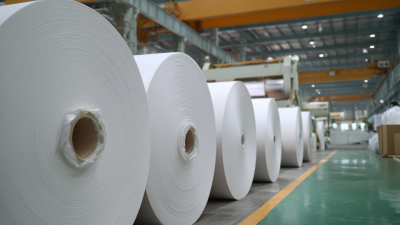Choosing the right Ultrasound Paper is crucial for achieving optimal imaging performance in medical diagnostics. Recent industry reports indicate that the quality of ultrasound imaging can significantly influence clinical outcomes; for instance, high-quality imaging can enhance detection rates in early-stage disease by up to 30%. The type of paper used in ultrasound printers plays a pivotal role in ensuring the durability and clarity of the images produced, impacting both diagnostic accuracy and patient management. With advancements in ultrasound technology, practitioners are increasingly confronted with an array of paper options designed to meet various imaging needs. This guide aims to navigate through the complexities of selecting the most suitable Ultrasound Paper, equipping healthcare professionals with the knowledge to make informed decisions that foster better patient care and support efficient clinical workflows.

When selecting ultrasound paper, understanding the various types available is crucial for achieving optimal imaging performance. Different ultrasound papers are designed to accommodate various imaging modalities, and each type has unique features that can impact the clarity and quality of the ultrasound images. For instance, high-quality thermal paper is often preferred for its superior contrast and durability, which are essential for detailed image analysis. Additionally, some papers are specifically coated to enhance ink adhesion, resulting in sharper images that maintain their quality over time.
Furthermore, analyzing the characteristics of ultrasound papers, such as thickness, opacity, and print compatibility, can greatly influence diagnostic accuracy. Thicker papers may provide better durability and resistance to tearing, while opaque options ensure that backlighting does not interfere with image clarity. It's also important to consider the print technology being used, as some papers are engineered to work seamlessly with specific ultrasound machines, ensuring consistent results. By comparing these factors, healthcare professionals can make informed decisions and select the right ultrasound paper to enhance their imaging capabilities.
When it comes to ultrasound imaging, the quality of the ultrasound paper can significantly influence the outcome and clarity of the results. One of the key factors affecting ultrasound paper performance is its sensitivity. High-sensitivity papers are designed to capture faint signals with greater accuracy, enhancing the diagnostic capabilities of ultrasound machines. When selecting ultrasound paper, it is crucial to consider the manufacturer's specifications regarding sensitivity, as this can directly impact the resolution and detail in imaging.
Another important aspect is the durability of the ultrasound paper. It should withstand the rigors of daily use without deterioration, as prolonged exposure to heat and humidity can result in fading or distortion of images. Look for papers that offer high archival quality to ensure that ultrasound prints remain clear and legible over time. Additionally, the compatibility of ultrasound paper with different ultrasound machines is vital. Ensuring that the paper is suited for specific equipment can prevent potential issues with printing and image quality, ultimately leading to more reliable diagnostic results.
 When choosing ultrasound paper, it's crucial to understand the industry standards that influence imaging performance. The specifications of ultrasound paper can significantly impact the quality of the printed images. Key factors to consider include the paper's basis weight, brightness, and sensitivity. A higher basis weight ensures that the paper can handle the printing without curling or tearing, which helps maintain clarity and precision in the captured images.
When choosing ultrasound paper, it's crucial to understand the industry standards that influence imaging performance. The specifications of ultrasound paper can significantly impact the quality of the printed images. Key factors to consider include the paper's basis weight, brightness, and sensitivity. A higher basis weight ensures that the paper can handle the printing without curling or tearing, which helps maintain clarity and precision in the captured images.
Brightness levels affect the contrast of the prints; papers with higher brightness produce richer, more defined images, making it easier for healthcare professionals to analyze results.
Another essential specification is the sensitivity of the paper, which determines how well it responds to the ultrasound signals. Look for papers with high sensitivity ratings, as these are designed to capture detailed images accurately. Additionally, environmental factors such as temperature and humidity should not be overlooked. Ultrasound paper needs to withstand varying conditions without compromising its quality. By focusing on these specifications, practitioners can ensure they choose the right ultrasound paper, ultimately contributing to optimal imaging performance and enhanced diagnostic accuracy.
When it comes to ultrasound imaging, the choice of paper can significantly influence the quality and clarity of the results. One of the most critical aspects to consider is the thickness of the paper. Thicker paper tends to provide better durability and reduces the risk of curling or tearing, which can occur during handling or transport. However, it’s essential to balance thickness with the practicality of your ultrasound machine's paper feed. For optimal performance, aim for paper that is neither too thick nor too thin, allowing for seamless printing while maintaining high image quality.
In addition to thickness, the coating of the ultrasound paper plays a vital role in achieving the best results. A coated surface can enhance contrast and detail in the printed images, ensuring that crucial diagnostic information is preserved. When selecting ultrasound paper, consider options with a suitable coating that matches the type of ultrasound system being used. This choice can contribute to the sharpness of the images and help clinicians make informed decisions based on accurate representations of the scanned areas. By understanding the importance of paper thickness and coating, you can enhance the overall imaging performance of your ultrasound processes.
| Paper Type | Thickness (gsm) | Coating Type | Imaging Performance | Recommended Use |
|---|---|---|---|---|
| Standard Ultrasound Paper | 60 | Matte | Good | General Use |
| High-Resolution Paper | 70 | Glossy | Excellent | Detailed Imaging |
| Eco-Friendly Paper | 65 | Natural | Good | Sustainable Use |
| Quick-Dry Paper | 75 | Special Coating | Very Good | Fast Processing |
| Durable Paper | 80 | Water-Resistant | Excellent | Long-Term Archiving |
When it comes to selecting ultrasound paper, striking the right balance between cost and quality is imperative for maximizing efficiency in medical imaging. The financial dynamics within healthcare systems, particularly in the context of the NHS and its exploration of alternative payment mechanisms, highlight the importance of strategic investments in essential supplies. By prioritizing high-quality ultrasound paper, facilities can enhance imaging accuracy while potentially reducing the frequency of reprints, leading to better resource allocation and cost savings in the long run.

Furthermore, advancements in drying technologies play a crucial role in the production of ultrasound paper. These innovations not only contribute to cleaner production methods but also ensure that the final product maintains optimal quality. The integration of energy-efficient processes is critical for reducing emissions and reinforcing the sustainability of healthcare practices. As healthcare providers navigate the complexities of cost versus quality, focusing on these advancements can facilitate smarter purchasing decisions, ultimately benefiting patient care and operational efficiency.






